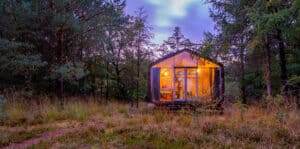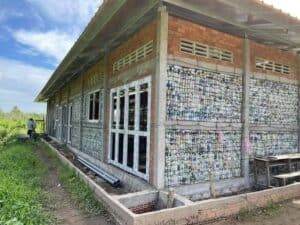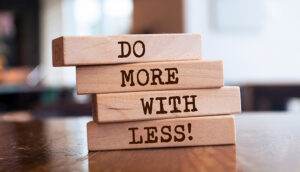What is Food Security?
Food security is the ability to have access to safe and nutritious food all year long without relying only upon what’s commercially available. Building a food security plan for your family or community is a great way to ensure everyone can eat regardless of the season or situation.
During emergencies or situations out of your control, such as inflation or shortages, something many of us are currently experiencing and has happened throughout history. We can grow, preserve, forage, stockpile food, or trade and barter with others doing the same things.
Whether you want more food security to be prepared during emergencies, to help offset the cost of living, or for just peace of mind knowing you and your family will always be able to eat, then organizing and planning now could be vital in unforeseen situations.
Short Term Food Preparedness
Planning for an emergency can help us set the foundation for building long-term food security. You can begin the process of working towards a sustainable food supply by starting with short-term goals. A great way to get started is to prepare a one to two-week emergency food and water supply.
While stocking up your pantry, it’s important to be mindful of saving a variety of food that satisfies all of your nutritional needs in order to maintain good health. While calories may be a primary concern, a pantry full of canned noodles won’t provide nearly enough nutrition to sustain your energy levels and health in the long run. Access to food doesn’t always mean access to healthy food.
The daily caloric needs for one adult is an average of 2000-2500 calories per day, which comes from protein, carbohydrates, and fats.
Most people enjoy a diet comprised of various sources of:
- Protein from meat, eggs, legumes, nuts & seeds.
- Carbohydrates from fruits, grains, and a variety of starchy vegetables.
- Fats from animal sources including meat, eggs, milk, and cheese or plant based fat sources such as avocados, olives, and many nuts and seeds.
Once you can work out the amount of food you will need for, say, 7 days, you will then be able to calculate the amount and kinds of foods you may want to stockpile for longer. Then you can plan how to acquire or grow, process, and store that food.
Diversify Your Food Supply for Long-Term Food Security
Planning for emergencies is one thing, but what about six months or 12 months’ worth of food? How can you ensure you will have access to enough of everything you need? A few cans of tuna, crackers, dried fruits, and canned vegetables might be a good choice for your 7-day emergency food supply, but how can you translate that into a substantial stock of food?
Unless you’re an apocalypse prepper, the majority of people do not want to stock their shelves with grocery store canned and dry goods; In reality, that’s not food security; it is just stockpiling.
Long-term food security requires having multiple sources for obtaining food and various ways of processing that food; it also might mean collaborating with others, like, for example, local farmers, butchers, or bakers.
First, take an inventory of the foods you buy and eat all the time; those are your staple foods. Then, consider how you source those ingredients now and devise other ways to source those items.
If there’s no good way to either grow or alternatively source a particular food or ingredient, you may need to re-evaluate whether it fits into a sustainable long-term food security plan. That is how you begin to think about your future food.
Establishing Local Relationships to Build Community Resilience
You can begin to ask questions like where else can I get fresh vegetables and grains if not from the store? Where will I get protein, and what are the alternative options that I can grow, raise or find near me? Begin to explore your local communities and talk to farmers, market gardeners, and other local suppliers.
You will start to accumulate a network of people who can provide the food and/or services that will contribute to you reaching your food security goals. These people may also become partners to trade with in emergencies if you have stock to share or trade.
Building a network of people who know how to grow, raise, butcher, cook, and make things will contribute to your food security. Consider these relationships vital for survival, not to mention supporting your local business, keeping money in your community, and helping real people, not industry, thrive.
Embrace Multiple Methods of Growing Food
Besides planning your emergency food supply and stockpiling now, finding local suppliers and producers and learning how to grow your own food are some of the most vital steps toward reaching food security.
Growing food can be done in various ways depending on where you live. Whether you have a substantial lot of land, an urban backyard, or no yard, you can still grow food. Of course, there may be limits to how much you grow, but nonetheless, almost everyone can produce something on their own.
Community gardens are available all over the country, and many places, including cityscapes, are creating new areas for people to grow food.
Until you have space of your own, utilize these resources and ask friends and family who have yards if they are willing to share space or allow you to take it over if it is unused. There is no harm in asking, especially if they are also interested in building food security; it could be just the push they need to start.
Container gardening and indoor growing are another way to grow food. Plenty of crops can be grown using methods like hydroponics, aquaponics, and aeroponics systems, which will grow year-round leafy greens, herbs, and smaller fruit and vegetable plants.
Many of these up-to-date versions of these systems use less water energy and sometimes no soil. If you can’t run extra power or don’t have space, growing a few micro greens on a windowsill or sprouts in a jar is the next best option.
Home gardens, big and small, can provide a ton of food. Urban food forests are quickly rising, and people are learning to create abundance in a small space by planting perennial plants, edible cover crops, companion planting, and building soil through permaculture practices.
Gardening doesn’t mean you have to dig either; raised beds and no-dig gardening can work in any space. Consider growing food in as many different ways as you can for abundance. The more techniques you can use to grow food, the more food you will have access to.
What Food Should You Grow?
If you want to make a meaningful contribution to your food security, then focus on growing food that your family will actually eat. While experimenting with growing unfamiliar vegetables (especially climate-adapted perennials) is a great way to discover new foods which may ultimately become a staple in your diet, you want to make sure all the effort of growing food makes an impact and is actually eaten.
First, list your staple foods, then research what species will thrive in your area or perhaps already grows wild.
For example, I reside on the east coast or in North America, which has perfect conditions for potatoes, turnips, carrots, blueberries, strawberries, and apples; those items are also my staple foods, the food we eat and buy all the time. So, it makes sense to plant or forage more of these items because they are abundant in this area, and we enjoy them.
If you eat a lot of out-of-zone plants (imported food), consider relocating your palate to a bit more localized foods; in crisis or rising cost situations, these ingredients might not be readily available; know what other option you have.
We can create abundant gardens by acquiring seeds, cuttings, or roots for growing various crops. When first purchasing seeds, I’d recommend buying seed varieties that will grow in your planting zone and, more importantly, an open pollination variety that you can continue to save seeds from each season.
In addition, heirloom or heritage seeds contribute to the passing of knowledge about the history behind our food, which ensures we always have those same seeds available for future generations.
If you cannot purchase seeds, the next best thing is to save seeds from the organic fruits and vegetables you buy, especially from local growers. Obviously, you won’t know the history of the seed, but you have to eat quantity over quality sometimes.
As much as I advocate for biodiversity, I’m more for families having food to eat and saving seeds however you can, yet when investing money in seeds, try your best to learn about the varieties that benefit you and the planet.
Plant Propagation to Grow More for Less
Seeds are not the only way to grow food; propagating cuttings from an established plant can be rooted to create new plants. For example, Tomato plants are famous for extra branches we call suckers; when you pull off the suckers and put them in water, or directly in consistently moist soil within 5-7 days, new roots will appear, and each sucker will become a new plant.
You can do this with many plants, especially perennial herbs, fruit and nut trees, and many species of plants. Some plants are propagated from tubers, roots, rhizomes, and stems.
For example, a sweet potato grows from a slip which is nothing more than a cutting from the sweet potato vine. We can grow slips by planting all or a piece of the potato in soil or water. The slip usually looks like a green vine which is later removed from the potato and rooted, just like the tomato suckers that create a new plant. Regrowing food from the food you grew or purchased is another step towards building food security.
Foraging Wild Edibles
Lastly, I want to encourage you to learn about native food that grows near you; ancient food knowledge is vital for food security. What if you can’t get wheat grain or seed potatoes and did not save them yourself?
Are there alternative options you could forage or harvest locally that you can substitute for those staple foods but also provide nutrition? In many rural locations, there is an abundance of wild food that we still need to be educated about.
For example, I discovered I have a ton of lamb quarters growing on my land; as it turns out, this is wild quinoa, which is a protein source. In an emergency, I have this free food source already growing on my property for added nutrition or as an alternative ingredient to save money. Learning about nature in your area is a benefit I can’t emphasize enough.
The planet is full of food and medicine for free. All we have to do is take the time to learn about it. I use a plant Identification app alongside a native plant book to Id species near me, and the apps are usually free; you can download books or borrow them free at the library.
Planning for Long Term Food Storage
Stockpiling purchased food is how we can begin to build an emergency food supply. Yet as you start to grow, forage and save your own, it is vital to learn proper preservation methods for long-term food storage.
There are many ways to preserve food, and I encourage you to try them all! The goal for preserving food is to have various options available between the garden and hunting seasons. The more you preserve, the less food you have to buy.
Most of us have a fridge, freezer, and pantry cupboards, where we keep the food we buy from the store. These are also the places we will store food we grow and forage. The more food you plan on preserving and stockpiling, the more space you need; keep this in mind as you begin planning.
It’s a good idea to preserve food in different ways so you are not reliant on only one source. Imagine freezing everything you grew, foraged, and hunted as your only preserving method, only to have a power outage that last days longer than the fuel you had for the backup power.
Consider that emergencies happen, and part of food security is having what you need at any time with backup options. A freezer full of thawed food is no good. Preserving food in different ways allows you to be prepared for just-in-case situations.
Food Preservation Methods
Canning
One method of preserving food is canning; Water bath canning is easy, relatively cheap to start, and an excellent option for beginners. Water bath canning is a great option for high-acid foods, like fruits made into syrups, compotes, purees, jams, jelly, pickles and relish, salsa, and tomatoes.
Pressure canning is a bit more advanced but an essential skill to learn. When we pressure can foods using specific weights and times, we can safely preserve low-acid foods for a long time without use of a freezer.
For example, a pressure canner will cook and seal meat, beans, vegetables, stocks, soups, chili, and more. It will require some investment for the equipment, but I assure you, it’s worth the money if you want a fully stocked ‘cantry.’
Dehydrating
Other preserving methods include dehydrating food, including items such as meat and veggie jerky, fruit chips and leathers, dried herbs and spices, etc.
You can use the sun to dry your food using premade or homemade racks, nets, or electric dehydrators indoors. Alternatively, you can dry near a woodstove or in an oven on low.
Freeze-Drying
Freeze-drying is another method that will preserve food for up to 25 years in some cases, and this is an excellent way to ensure your food will last a long time.
However, the proper equipment is required for freeze-drying, and they are costly. But, again, another good investment if you want a fully stocked pantry.
Fermentation
Fermenting is another way to preserve food for a long time. Fermenting is the process of converting foods’ natural sugars into edible, healthy, and acidic products.
You may be familiar with common fermented foods like kimchi, sauerkraut, soy sauce, and chocolate, and you can ferment food like these at home. However, like all the methods mentioned, fermenting takes some education, practice, and patience.
Freezing
And, of course, as mentioned, freezing is another method for preserving food; altogether, there are many options for ensuring you can stock and store food for a long time.
For example, we can preserve fresh food in a cold cellar for months longer than in the fridge; consider adding a cold storage area so you can preserve fresh food like potatoes, cabbage, apples, squash, garlic, and onions for months in between growing seasons.
There are just so many ways we can preserve food for tomorrow. Start with the easy and cheap methods, and eventually, canning, drying, and freezing will be routine habits that you practice naturally.
Concluding Thoughts
As Francis Bacon once said, “knowledge is power,” and I couldn’t agree more when it comes to planning and practicing food security. The more you know, the more power you have over your food and, ultimately, your health. We have but one short life and so much to learn.
Learning skills and gaining knowledge about the essential tools for living resourcefully is the information we can pass on to future generations. It is also how we can build thriving communities that are more self-sufficient, use fewer resources, and have less reliance on the economy.
Growing, foraging, conserving, and preserving are skills that contribute to survival for enduring in times of peace and abundance or times of distress and shortages. Take back control over your food security by thinking about what you eat, how you eat, and where your food comes from, and begin finding new ways to source your groceries, cut costs, and have more abundance.








